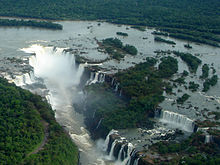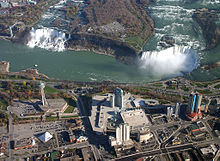Waterfall

Angel Falls in Venezuela is the world's tallest waterfall at 979 m (3,212 ft).
A waterfall is a place where water flows over a vertical drop or a series of steep drops in the course of a stream or river. Waterfalls also occur where meltwater drops over the edge of a tabular iceberg or ice shelf.
Formation
Waterfalls are commonly formed in the upper course of a river in steep mountains.[1]Because of their landscape position, many waterfalls occur over bedrock fed by little contributing area, so may be ephemeral and flow only during rainstorms or significant snowmelt. The further downstream, the more perennial a waterfall can be. Waterfalls can have a wide range of widths and depths, and this diversity is part of what makes them such a charismatic and interesting natural phenomenon. Research into the diversity of natural waterfalls systematics has been carried out in recent years.[2][3]

Aerial view of Victoria Fallson the Zambezi River in southern Africa. The cloud formed by the mist is calledcataractagenitus.[4]
When the river courses over resistant bedrock, erosion happens slowly and is dominated by impacts of water-borne sediment on the rock, while downstream the erosion occurs more rapidly.[1][5] As the watercourse increases its velocity at the edge of the waterfall, it may pluck material from the riverbed, if the bed is fractured or otherwise more erodable. Hydraulic jets and hydraulic jumps at the toe of a falls can generate large forces to erode the bed[6], especially when forces are amplified by water-borne sediment. Horseshoe-shaped falls focus the erosion to a central point, also enhancing riverbed change below a waterfalls[7]. A process known as "potholing" involves local erosion of a potentially deep hole in bedrock due to turbulent whirlpools spinning stones around on the bed, drilling it out. Sand and stones carried by the watercourse therefore increase erosion capacity.[1] This causes the waterfall to carve deeper into the bed and to recede upstream. Often over time, the waterfall will recede back to form a canyon or gorge downstream as it recedes upstream, and it will carve deeper into the ridge above it.[8] The rate of retreat for a waterfall can be as high as one-and-a-half metres per year.[1]
Often, the rock stratum just below the more resistant shelf will be of a softer type, meaning that undercutting due to splashback will occur here to form a shallow cave-like formation known as a rock shelter under and behind the waterfall. Eventually, theoutcropping, more resistant cap rock will collapse under pressure to add blocks of rock to the base of the waterfall. These blocks of rock are then broken down into smaller boulders by attrition as they collide with each other, and they also erode the base of the waterfall by abrasion, creating a deep plunge pool in the gorge downstream.
Streams can become wider and shallower just above waterfalls due to flowing over the rock shelf, and there is usually a deep area just below the waterfall because of the kinetic energy of the water hitting the bottom. However, a study of waterfalls systematics reported that waterfalls can be wider or narrower above or below a falls, so almost anything is possible given the right geological and hydrological setting.[3] Waterfalls normally form in a rocky area due to erosion. After a long period of being fully formed, the water falling off the ledge will retreat, causing a horizontal pit parallel to the waterfall wall. Eventually, as the pit grows deeper, the waterfall collapses to be replaced by a steeply sloping stretch of river bed.[1] In addition to gradual processes such as erosion, earth movement caused by earthquakes orlandslides or volcanoes can cause a differential in land heights which interfere with the natural course of a water flow, and result in waterfalls.
A river sometimes flows over a large step in the rocks that may have been formed by afault line. Waterfalls can occur along the edge of a glacial trough, where a stream or river flowing into a glacier continues to flow into a valley after the glacier has receded or melted. The large waterfalls in Yosemite Valley are examples of this phenomenon, which is referred to as a hanging valley. Another reason hanging valleys may form is where two rivers join and one is flowing faster than the other.[1] Waterfalls can be grouped into ten broad classes based on the average volume of water present on the fall (which depends on both the waterfall's average flow and its height) using a logarithmic scale. Class 10 waterfalls include Niagara Falls,Paulo Afonso Falls and Khone Falls.
Classes of other well-known waterfalls include Victoria Falls and Kaieteur Falls (Class 9); Rhine Falls and Gullfoss (Class 8); Angel Falls and Dettifoss (Class 7); Yosemite Falls,Lower Yellowstone Falls and Umphang Thee Lor Sue Waterfall (Class 6); Sutherland Falls(Class 5).[9]
Researchers
Alexander von Humboldt (1820s) "Father of Modern Geography" Humboldt was mostly marking waterfalls on maps for river navigation purposes.
Oscar von Engeln (1930s) Published "Geomorphology: systematic and regional", this book had a whole chapter devoted to waterfalls, and is one of the earliest examples of published works on waterfalls.
R. W. Young (1980s) Wrote "Waterfalls: form and process" this work made waterfalls a much more serious topic for research for modern Geoscientists.[10]
Types

An example of an ephemeralwaterfall. This one, when flowing, feeds into the Chagrin River (Ohio).
- Ledge waterfall: Water descends vertically over a vertical cliff, maintaining partial contact with the bedrock.[11]
- Plunge: Fast moving water descends vertically, losing complete contact with the bedrock surface.[11] The contact is typically lost due to horizontal thrust of the water before it falls. It always starts from a narrow stream.
- Punchbowl: Water descends in a constricted form and then spreads out in a wider pool.[11]
- Horsetail: Descending water maintains contact with bedrock most of the time.[11]
- Cascade: Water descends a series of rock steps.[5][11]
- Tiered/Multi-step/Staircase: A series of waterfalls one after another of roughly the same size each with its own sunken plunge pool.[11]
- Cataract: A large, powerful waterfall.[11]
- Segmented: Distinctly separate flows of water form as it descends.[11]
- Catadupa: A cataract or waterfall, originally those of the Nile. The term catadupaerefers to people inhabiting near such cataracts; there are suppositions that these people are deaf due to the constant din.[12]
- Frozen: Any waterfall which has some element of ice or snow.[11]
- Moulin: A moulin is a waterfall in a glacier
Examples
Significant waterfalls,[16] listed alphabetically:

Staubbach Falls, a 297-metre (974 ft) waterfall in Switzerland
- Angel Falls in Venezuela is the world's tallest above-water waterfall at 979 metres (3,212 ft).
- Aysgarth Falls in the Yorkshire Dales, England – which provided inspiration forRuskin, Turner and Wordsworth.
- Ban Gioc–Detian Falls, a transnational waterfall on the border between China and Vietnam.
- Bridalveil Fall in Yosemite Valley is 189 metres (620 ft) high with a sheer drop.
- Cumberland Falls in Kentucky is one of several falls in the world at which amoonbow is visible.
- Dettifoss in northeast Iceland is the largest waterfall in Europe in terms of volume discharge, having an average water flow of 200 m3/s.The falls are 100 metres (330 ft) wide and have a drop of 44 metres (144 ft) down to the Jökulsárgljúfur canyon.
- Eas a' Chual Aluinn in Scotland, at 200 metres (660 ft), the highest waterfall in the United Kingdom.
- Falls of Lora, also in Scotland, is an unusual rapids in the sea that is created when the waters in Loch Etive pour out through the narrow mouth of the loch over a rocky shelf.[17]
- Gocta, the sixteenth-tallest in the world at 771 metres (2,530 ft), is located in the province of Chachapoyas, Peru.
- Huangguoshu Waterfall in Anshun, Guizhou, China, is the largest waterfall in East Asia.
- Iguazu Falls is an extensive series of waterfalls along a 2.7-kilometre (1.7 mi) stretch of escarpment on the Argentina-Brazil border.
 Aerial view of Iguazu Falls on the Iguazu River between Brazil and Argentina
Aerial view of Iguazu Falls on the Iguazu River between Brazil and Argentina - James Bruce Falls, the tallest waterfall in North America at 840 metres (2,760 ft), is located in the Princess Louisa Marine Provincial Park, British Columbia, Canada.
- Jiao Lung Waterfall in Alishan, Chiayi, Taiwan, is the tallest waterfall in East Asia at 600 metres (2,000 ft).
- Jog Falls in Karnataka, India, is the second-highest plunge waterfall in India.
- Kaieteur Falls (Potaro River in centralGuyana), located in the Kaieteur National Park, is 226 metres (741 ft).
- Niagara Falls are the widest, most powerful falls in North America.
 Aerial view of Niagara Falls in the state of New York, United States, and province of Ontario, Canada
Aerial view of Niagara Falls in the state of New York, United States, and province of Ontario, Canada - Nohkalikai Falls is India's tallest plunge waterfall, located in Meghalaya state, India.
- Pissing Mare Falls, at 350 metres (1,150 ft), is one of the tallest waterfalls in eastern North America.
- Ramnefjellsfossen in Stryn, Nesdalen, Norway, is the world's third-tallest waterfall at 808 metres (2,651 ft).
- Reichenbach Falls in Switzerland, a sequence of two waterfalls totaling 120 metres (390 ft) in height, were the site of the disappearance and purported death of fictional detective Sherlock Holmes in the story "The Final Problem".
- Rhine Falls near Schaffhausen, Switzerland, are among the largest in Europe, at 150 metres (490 ft) wide.
 Aerial view of Rhine Falls in Switzerland
Aerial view of Rhine Falls in Switzerland - Ribbon Fall, a seasonal waterfall in Yosemite National Park, is the highest single-drop fall in North America, at 1,612 feet (491 m).
- Shir-Abad Waterfall is located near Khan Bebin in Golestan Province, Iran.
- Shoshone Falls in Idaho has been termed the "Niagara of the West".
- St. Clair's Falls, Sri Lanka's widest waterfall, is 265 feet (81 m) tall.
- Takakkaw Falls, 384 metres (1,260 ft) high, are in Yoho National Park in Canada.
- Tequendama Falls is a 132-metre (433 ft) waterfall on the Bogotá River, about 30 kilometres (19 mi) southwest of Bogotá in Colombia.
- Tugela Falls is the world's second-tallest at 947 metres (3,107 ft) in KwaZulu-Natalprovince, Republic of South Africa.
- Venta Rapid in Latvia, said to be Europe's widest waterfall, is more than 800 feet (240 m) wide but only about 6 feet (1.8 m) high.
- Victoria Falls, on the Zambezi river along the border between Zimbabwe and Zambia, is among the largest waterfalls in the world. During periods of high flow, it creates an unbroken sheet of water more than a mile wide.
- Virginia Falls (Northwest Territories) onSouth Nahanni River, Northwest Territories, Canada, is the world's 14th-largest waterfall located in Nahanni National Park Reserve, aUNESCO World Heritage Site.
- Waihilau Falls, at 792 metres (2,598 ft), is located in the Waimanu Valley, Hawaii, United States.
- Yosemite Falls, 739 metres (2,425 ft), located in Yosemite National Park, United States.
- Yumbilla Falls is the world's fifth-tallest waterfall and located in Peru.

Comments
Post a Comment